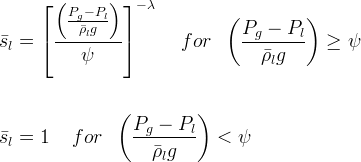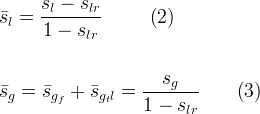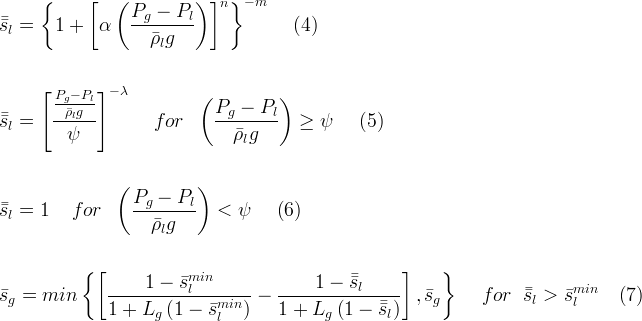STOMP User Guide
STOMP User Guide
Saturation Function Card Options
Saturation functions relate the gas-aqueous capillary pressure to aqueous, gas, and entrapped gas saturations. Model options and parameters for these functions are specified through the Saturation Function Card. Every rock/soil type defined on the Rock/Soil Zonation Card must be referenced. With the IJK Indexing option, node dependent parameters are entered via external files and node independent parameters are entered directly on the card. Functional forms for the saturation-capillary pressure functions are preferred; however, tabular input is acceptable. By default, tabular data will be interpolated using linear interpolation, whereas values beyond the table limits will be assigned either the table minimum or maximum values appropriately.
- van Genuchten
- Brooks and Corey
- Haverkamp
- Gas Entrapment
- Webb Extension
- Fractured Media
- Tabular Input
van Genuchten Functional Form
This option uses the van Genuchten (1980) retention function.

where

| Symbols | |
 |
effective aqueous liquid saturation |
 |
gas pressure, Pa |
 |
aqueous liquid pressure, Pa |
 |
van Genuchten function parameter, 1/m |
 |
van Genuchten n parameter |
 |
van Genuchten m parameter |
 |
reference aqueous density, kg/m3 |
 |
acceleration of gravity, m/s2 |
Brooks and Corey Functional Form
The Brooks and Corey (1966) retention function is used.

| Symbols | |
 |
effective aqueous liquid saturation |
 |
gas pressure, Pa |
 |
aqueous liquid pressure, Pa |
 |
reference aqueous density, kg/m3 |
 |
acceleration of gravity, m/s2 |
 |
Brooks and Corey lambda parameter |
 |
Brooks and Corey function nonwetting fluid entry head, m |
Haverkamp Functional Form
The Haverkamp et al. (1977) retention function is used.

| Symbols | |
 |
volumetric water content |
 |
residual water content |
 |
saturated water content |
 |
capillary head, m |
 |
Haverkamp α parameter |
 |
Haverkamp β parameter |
Gas Entrapment
This option considers entrapped gas that is immobile and also reduces the pore fraction for the mobile fluid.
A theoretical model for hysteretic saturation functions for aqueous-gas systems was developed by Parker and Lenhard [1987]. A simplified version of this model, analogous to Kaluarachchi and Parker [1992], has been implemented in the STOMP simulator. The model includes effects of gas entrapment during aqueous-phase imbibition paths. Gas entrapment during aqueous-phase imbibition will depend on the aqueous saturation and the current saturation path. The amount of entrapped gas varies linearly between zero and the gas effective residual saturation with the apparent saturation, which varies between the reversal point from main drainage to one. Gas effective residual saturations are computed using an empirical relationship developed by Land [1968] for aqueous-NAPL systems. In this simplified hysteretic model for aqueous-gas systems, gas can be trapped or free, where free gas refers to continuous volumes which advect freely, and trapped gas refers to discontinuous ganglia of gas occluded within the aqueous phase. Occluded gas is assumed to be immobile. The apparent aqueous saturation equals the effective aqueous saturation plus effective trapped gas saturation, as shown in the Equation 1 below. The effective gas saturation equals the effective trapped and free gas saturations, as shown in Equation 3. In hysteretic systems, the residual saturation is independent of capillary pressure.

where

The saturation functions relate gas-aqueous capillary pressure to apparent aqueous saturations, according to equations (4) and (5), for the van Genuchten and Brooks and Corey functions, respectively. The effective trapped gas saturation is computed according to equation (7), which recognizes that entrapped gas cannot exceed the gas present. Land’s parameter for gas-aqueous interfaces is computed according to equation (8).

where

| Symbols | |
 |
apparent aqueous liquid saturation |
 |
effective aqueous liquid saturation |
 |
effective gas saturation trapped by aqueous phase |
 |
actual aqueous liquid saturation |
 |
actual aqueous liquid residual saturation |
 |
effective gas saturation |
 |
effective free gas saturation |
 |
actual gas saturation |
 |
van Genuchten function parameter, 1/m |
 |
van Genuchten n parameter |
 |
van Genuchten m parameter |
 |
gas pressure, Pa |
 |
aqueous liquid pressure, Pa |
 |
reference aqueous density, kg/m3 |
 |
acceleration of gravity, m/s2 |
 |
Brooks and Corey function nonwetting fluid entry head, m |
 |
Brooks and Corey parameter |
 |
minimum effective aqueous liquid saturation |
 |
maximum effective residual gas saturation |
 |
Land's parameter for gas-aqueous interface |
Webb Extension
To extend the saturation function below the aqueous residual saturation, functional extensions are required. STOMP-CO2 and -CO2E recognize the Webb (2000) model. This function works with both the van Genuchten and Brooks and Corey characteristics functions, without requiring additional input as the oven-dried head is assumed to be equal to a capillary pressure of 109 Pa (~105 m).
Fractured Media (Equivalent Continuum)
This option is used for a fractured medium. The retention properties for both the fracture and the matrix are needed. Dual porosity functions or equivalent continuum models for aqueous-gas systems relate the gas-aqueous capillary pressure to the bulk aqueous saturation for fractured geologic media through two functions [Klavetter and Peters 1986; Nitao 1988]. One function relates the gas aqueous capillary pressure to the matrix aqueous saturation and the other relates the gas-aqueous capillary pressure to the fracture aqueous saturation. The pivotal assumption associated with the dual porosity function is that the fracture and matrix pressures are in equilibrium. This assumption neglects transient fracture-matrix interactions. Fracture and matrix effective saturations can be computed with either van Genuchten or Brooks and Corey functions above. The bulk aqueous saturation is computed by combining the fracture and matrix aqueous saturations and diffusive porosities:

where the actual saturations are computed from effective saturations, according to

| Symbols |  |
actual aqueous liquid saturation |
 |
actual aqueous liquid saturation of the fracture material |
 |
actual aqueous liquid saturation of the matrix material |
 |
actual aqueous liquid residual saturation of the fracture material |
 |
actual aqueous liquid residual saturation of the matrix material |
 |
effective aqueous liquid saturation of the fracture material |
 |
effective aqueous liquid saturation of the matrix material |
 |
diffusive porosity of the fracture material |
 |
diffusive porosity of the matrix material |
Tabular Input
This option accepts tabulated retention data. The default is the data of pressure head and saturation data pairs and linear interpolation is used between data points. Alternately, water content vs capillary head can be provided using the keyword "water content." Other interpolation schemes that can be specified are linear-log, cubic spline, or cubic-spline-log.
Brooks, RH and AT Corey. 1966. "Hydraulic Properties of Porous Media Affecting Fluid Flow," Proc. ASCE J. Irrig. Drain. Div. , 92:61-68.
Haverkamp, R, M Vauclin, J Touma, PJ Wierenga, and G Vachaud. 1977. "A Comparison of Numerical Simulation Models for One-Dimensional Infiltration," Soil Sci. Soc. Am. J., 41:285-294.
Kaluarachchi, JJ and JC Parker. 1992. "Multiphase Flow with a Simplified Model for Oil Entrapment," Transport in Porous Media, 7:1-14.
Klavetter, EA and RR Peters. 1986. Estimation of Hydrologic Properties of Unsaturated Fractured Rock Mass, SAND84-2642, Sandia National Laboratories, Albuquerque, NM.
Land, CS. 1968. "Calculation of Imbibition Relative Permeability for Two- and Three-Phase Flow from Rock Properties," Trans. Am. Inst. Min. Metall. Pet. Eng., 243:149-156.
Nitao, JJ. 1988. Numerical Modeling of the Thermal and Hydrological Environment around a Nuclear Waste Package Using the Equivalent Continuum Approximation: Horizontal Emplacement, UCID-2144, Lawrence Livermore National Laboratory, Livermore, CA.
Parker, JC and RJ Lenhard. 1987. "A Model for Hysteretic Constitutive Relations Governing Multiphase Flow 1. Saturation-Pressure Relations," Water Resources Research, 23(12):2187-2196.
van Genuchten, MT. 1980. "A Closed-Form Equation for Predicting the Hydraulic Conductivity of Unsaturated Soils," Soil Science Society of America Journal, 44:892-898.
Webb, S. W., 2000. “A simple extension of two-phase characteristic curves to include the dry region.” Water Resources Research, 36(6):1425-1430.